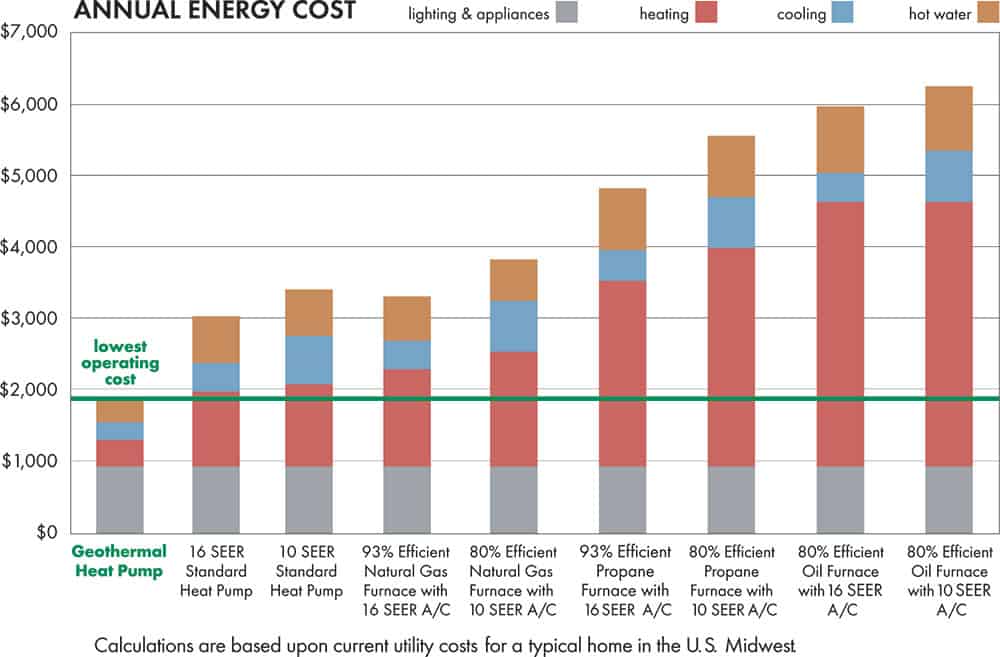Geothermal Heating Company in Northern Atlanta and Marietta
Atlanta summers can be hot, but winters can get chilly. A geothermal heating system may be just the perfect solution for your home, as it provides many benefits in terms of its efficiency, low maintenance requirements, and cost savings over time. Most importantly, the energy it extracts from the earth will keep you warm and toasty during the winter!
Our team of geothermal system installers is trained to install geothermal heating and cooling systems for Atlanta area homes and businesses. Whether you’re interested in geothermal as a way to save money, protect the environment or both, contact us for information on geothermal heating and cooling system installation in Marietta, GA, today.
Save Money with Geothermal
Compared to conventional methods of heating and cooling, Geothermal Comfort Systems save owners money. Based on lower utility bills, these systems usually pay for themselves after 5-10 years. The average household savings is $129 a month, as much as 70%. The total energy consumption can be reduced as much as 44%.
"Based on lower utility bills, geothermal comfort systems usually pay for themselves after 5-10 years."
A geothermal heating and cooling system taps into the renewable energy in the Earth’s surface to heat and cool your home or business. The underground water pipes harness the earth’s temperature to save you up to 70% on your utility bills when compared to a conventional system. Instead of burning expensive fossil fuels, a ground source heat pump is able to extract it’s energy from the earth, magnify it, and release it to heat your home in the winter.
During hot, Atlanta summers, a geothermal system only has to work as hard as your AC would if it were 58 degrees outside, and that is quite an energy savings! Geothermal systems are truly the future of heating and cooling systems.
Geothermal Heat Pump and Geothermal System
Advantages of Geothermal Energy
If you’re looking into geothermal heating and cooling or geothermal energy for electrical appliances, keep in mind that it doesn’t involve any form of combustion. This is one of the best advantages of geothermal energy! Geothermal has less greenhouse gas emissions, and binary geothermal power plants release NO greenhouse gases. Geothermal power plants generate 1/8th of the CO2 emissions associates with typical coal power plants.
The geothermal heat pumps used for heating and cooling are also considered one of the most efficient options available. This status is due to their low electricity requirement (electricity is only used to operate the unit’s fan, compressor and pump). Plus, geothermal energy has a small land-use footprint, producing huge amounts of electricity without taking up much space. Even the United States Environmental Protection Agency agrees that geothermal heating and cooling is the most environmentally-safe and cost-effective option on the market.
Utility bill savings
There is a high up-front cost for geothermal energy systems, mostly due to the expensive buried loop systems that are required. However, this initial cost is offset by the savings you’ll receive in the long run. Once the system is running, utility bills can decrease by up to 50%, one of the most popular advantages of geothermal energy In fact, a 30%-60% savings on heating and 25%-50% saving on cooling can cover the initial cost within three years. Lower maintenance costs mean it can be installed and then left alone for years afterward.

To alleviate the financial strain, many institutions offer to tie the upfront cost of installation to monthly mortgage remittances or other interest financing options. A 2,000 square-foot home can be heated and cooled for as little as $1/day with a geothermal system. Plus, you can have it set up to supplement your home’s conventional water heater, saving you up to 30% on hot water costs every year. With a simple modification, you can have your geothermal system generating some, if not all, of your hot water. Hot water is stored in your water heater for later use, and heat extracted from the building is sent to the water heater during the cooling cycle. This savings calculator tells you how much you can expect to save by switching to geothermal energy.
Our team of geothermal system installers is trained to install geothermal heating and geothermal cooling systems for Atlanta area homes and businesses. Whether you’re interested in geothermal as a way to save money, protect the environment or both, contact Cool Air Mechanical for information on geothermal heating and cooling system installation in Marietta, GA, today.









